|
|
2016年, 第3卷, 第1期 刊出日期:2016-01-01
|
上一期
下一期 |
|
|
|
|
|
PMEPA1 guards against TGF-β-mediated prostate cancer bone metastasis
Alexandra M. Blee, Haojie Huang
Asian Journal of Urology, 2016, 3(1): 1-3.
doi:10.1016/j.ajur.2015.11.002
 摘要
摘要
(
401 )
 PDF
PDF (935KB)
(
463
)
In advanced-stage prostate cancer, bone metastases are often incurable and cause chronic pain, bone fractures, and decreased quality of life. Researchers have previously identified that transforming growth factor-b (TGF-b) signaling is an important regulator of bone metastases in prostate cancer and that targeting TGF-b signaling is a promising therapeutic strategy [1,2].
参考文献 |
相关文章 |
计量指标
|
|
|
Acute kidney injury in China: A neglected truth and perspective
Cheng Yang, Bin Yang
Asian Journal of Urology, 2016, 3(1): 4-5.
doi:10.1016/j.ajur.2015.11.001
 摘要
摘要
(
349 )
 PDF
PDF (307KB)
(
366
)
Acute kidney injury (AKI) affects approximately 13.3 million individuals and contributes to about 1.7 million deaths globally per year. As estimated 85% of those affected live in the developing world [1]. Although there are various measures to prevent or treat AKI, including renal protective drugs and continuous renal replacement therapy, most of them have limited success or are still in their infancy [2,3].
参考文献 |
相关文章 |
计量指标
|
|
|
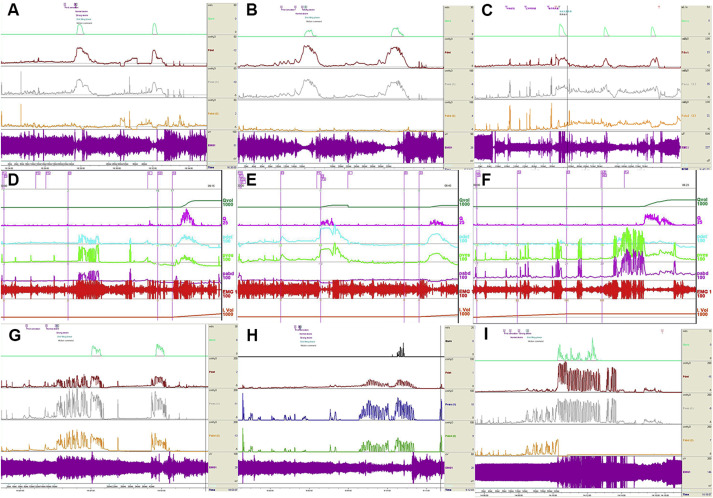
Relationship between urodynamic patterns and lower urinary tract symptoms in Chinese women with a non-neurogenic bladder
Linhui Wang, Cunzhou Wang, Chuangyu Qu, Lei Yin, Danfeng Xu, Xingang Cui, Bing Liu
Asian Journal of Urology, 2016, 3(1): 10-19.
doi:10.1016/j.ajur.2015.11.004
 摘要
摘要
(
427 )
 PDF
PDF (4951KB)
(
305
)
Objective: To investigate the urodynamic study (UDS) patterns, obstruction status, continence status, and their correlations among neurologically intact women with lower urinary tract symptoms (LUTS) through an epidemiological and logistic regression analyses.
Methods: We retrospectively analyzed the UDS data of 3265 neurologically intact women with LUTS (2002-2014). Five UDS patterns were identified: normo-active detrusor/sphincter (NA, or DSI, detrusor/sphincter intact), idiopathic detrusor overactivity (IDO), idiopathic sphincter overactivity (ISO), IDO + ISO, and detrusor underactivity (DUA). Analyses of UDS pattern distribution and stratification were performed (based on a modification of the European Urological Association-Madersbacher classification system), and their correlations with bladder outlet obstruction (BOO) and stress urinary incontinence (SUI) status were evaluated via logistic regression analysis.
Results: NA, IDO, IDO + ISO, ISO, and DUA were noted in 927 (28.4%), 678 (20.8%), 320 (9.8%), 689 (21.1%), and 651 (19.9%) cases, respectively. Moreover, storage, storage + voiding, and voiding symptoms were noted in 62.4%, 21.1%, and 16.5% cases, respectively, whereas BOO and SUI were observed in 12.1% and 29.0% cases, respectively. The risk factors for BOO included NA, IDO, ISO, and IDO + ISO, whereas the protective factors against BOO included storage symptoms, SUI, storage + voiding symptoms, and complaint duration within 1-12 months. NA was the only risk factor for SUI, whereas BOO, storage + voiding symptoms, IDO, and storage symptoms were protective factors for SUI.
Conclusion: Five UDS patterns were identified among neurologically intact women with LUTS. Functional abnormalities of the detrusor and/or sphincter were the main causes of LUTS, and were correlated with the BOO or SUI status. Thus, the UDS pattern can provide additional information regarding the risk factors for BOO or SUI status, as compared to symptomatic typing.
参考文献 |
相关文章 |
计量指标
|
|
|
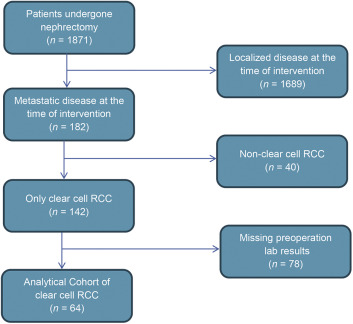
Elevated preoperative neutrophil-to-lymphocyte ratio may be associated with decreased overall survival in patients with metastatic clear cell renal cell carcinoma undergoing cytoreductive nephrectomy
Yoram S. Baum, Dattatraya Patil, Jonathan H. Huang, Stephanie Spetka, Mersiha Torlak, Peter T. Nieh, Mehrdad Alemozaffar, Kenneth Ogan, Viraj A. Master
Asian Journal of Urology, 2016, 3(1): 20-25.
doi:10.1016/j.ajur.2015.09.004
 摘要
摘要
(
371 )
 PDF
PDF (781KB)
(
217
)
Objective: Inflammatory serum markers have proven to be a powerful predictive tool of patient prognosis in cancer treatment for a wide variety of solid organ malignancies, predominantly in the context of localized disease. In this study we evaluated the preoperative neutrophil-to-lymphocyte ratio (NLR) as a predictive tool in patients with metastatic clear cell renal cell carcinoma (RCC).
Methods: Sixty-four patients with metastatic clear cell RCC undergoing nephrectomy were selected. Only patients with preoperative NLR were included for survival analysis. Patients were categorized into high and low NLR score determined by plotting the NLR ROC curve. Multivariable analysis was performed.
Results: Median age was 60.8 years (38.2-81.2). Median follow-up time was 8.1 months (0.1-106.3). Fuhrman grade distribution was: 2 (3.1%) grade 1, 6 (9.4%) grade 2, 24 (37.5%) grade 3 and 32 (50.0%) grade 4. Median NLR score was 3.5 (1.4-31.0). NLR≥4 was associated with decreased overall survival compared toNLR < 4 (p=0.017).Multivariable survival analysis showed NLR≥4 as an independent predictor of survival (Hazard ratio (HR) 2.41, 95%CI 1.05-5.50, p=0.03).
Conclusion: Elevated preoperative NLR is associatedwith poor prognosis in patients withmetastatic kidney cancer. Preoperative NLR is a useful tool, which can predict prognosis, stratify patients for postoperative surveillance, and help guide decisions for therapy.
参考文献 |
相关文章 |
计量指标
|
|
|

Prostate cancer volume associates with preoperative plasma levels of testosterone that independently predicts high grade tumours which show low densities (quotient testosterone/tumour volume)
Antonio B. Porcaro, Aldo Petrozziello, Matteo Brunelli, Filippo Migliorini, Giovanni Cacciamani, Davide De Marchi, Nicolo' de Luyk, Irene Tamanini, Beatrice Caruso, Maria A. Cerruto, Claudio Ghimenton, Walter Artibani
Asian Journal of Urology, 2016, 3(1): 26-32.
doi:10.1016/j.ajur.2015.11.006
 摘要
摘要
(
420 )
 PDF
PDF (1441KB)
(
402
)
Objective: To investigate potential associations of preoperative total testosterone (TT) with tumor volume (TV) and grade of prostate cancer (PCa).
Methods: Patients who were under medications impacting on the hypothalamic-pituitaryadrenal-testis-prostate axis were excluded. TT was measured preoperatively at least 1 month after biopsies and TV was calculated on the removed prostate specimen. Other continuous variables included total prostate specific antigen (PSA), percentage of positive cores (P+) and weight (W) of the removed prostate. Patients were categorized according to the pathologic Gleason score (pGS) in 3 groups (pGS 6, 7 and > 7). Invasion of the seminal vesicles was coded as seminal vesicle invasion (SVI).
Results: The median levels of TT were significantly and increasingly higher from pGS 6 (14.7 nmol/L) to pGS 7 (15.0 nmol/L) and pGS > 7 (18.8 nmol/L). The median values of TV were also detected significantly and increasingly higher from pGS 6 (5.6 mL) to pGS 7 (8.1 mL) and pGS > 7 (14.8 mL). The median preoperative levels of PSA were also increasing from pGS 6 (5.9 mg/L) to pGS 7 (6.2 μg/L) and pGS > 7 (7.7 μg/L). There was a significant and positive correlation of TV to PSA, TT and P+. Multiple linear regression analysis showed that TV was significantly and independently predicted by TT, PSA and P+. High grade PCa (pGS > 7) independently associated with TV, TT, P+ and SVI. The median density values of TT relative to TV (quotient TT/TV) significantly decreased from pGS 6 (2.6 nmol/L/mL) to pGS 7 (1.9 nmol/L/mL) and pGS > 7 (1.4 nmol/L/mL). The median density values of PSA relative to TV (quotient PSA/TV) also significantly decreased from pGS (1.1 μg/L/mL) to pGS 7 (0.7 μg/L/mL) and pGS > 7 (0.6 μg/L/mL).
Conclusion: The investigation shows that TT relates to volume and grade of PCa; moreover, the density of TT relative to TV inversely associates with rate of increase of cancer that depends on the grade of the tumour.
参考文献 |
相关文章 |
计量指标
|
|
|
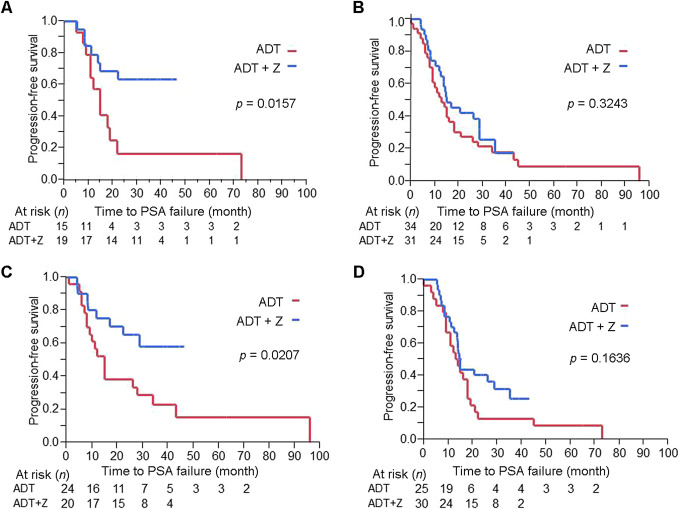
Zoledronic acid combined with androgen-deprivation therapy may prolong time to castration-resistant prostate cancer in hormone-naïve metastatic prostate cancer patients-A propensity scoring approach
Kazuhiro Nagao, Hideyasu Matsuyama, Masahiro Nozawa, Isao Hara, Tsukasa Nishioka, Takahiro Komura, Atsunobu Esa, Shigeya Uejima, Masaaki Imanishi, Yasunari Uekado, Takatoshi Ogawa, Hiroshi Kajikawa, Hirotsugu Uemura
Asian Journal of Urology, 2016, 3(1): 33-38.
doi:10.1016/j.ajur.2015.10.003
 摘要
摘要
(
356 )
 PDF
PDF (2260KB)
(
326
)
Objective: To clarify the oncological benefit of zoledronic acid for hormone-naïve metastatic prostate cancer, patient outcome of androgen deprivation therapy with zoledronic acid (ADT + Z) and androgen deprivation therapy alone (ADT) was compared.
Methods: Fifty-two patients with pathologically confirmed metastatic prostate cancer were prospectively enrolled and treated with combined androgen blockade (goserelin and bicalutamide) with zoledronic acid (4 mg every 4 weeks for 24 months). A propensity score-match with logistic regression analysis was applied to select 50 pair-matched cohorts (both from ADT + Z and from historical control cohorts who had undergone ADT alone), and patient outcomes were compared.
Results: Patients with ADT + Z had significantly longer time to progression (TTP) than those with ADT (median TTP; 24.2 vs. 14.0 months, p = 0.0092), while no significant difference of overall survival between two groups (p = 0.1502). Multivariate analysis for biochemical recurrence revealed treatment with ADT was the sole independent prognostic factor (HR: 1.724, 95% CI: 1.06-2.86, p = 0.0297).
Conclusion: Combination of zoledronic acid with ADT may prolong time to castration resistant prostate cancer.
参考文献 |
相关文章 |
计量指标
|
|
|
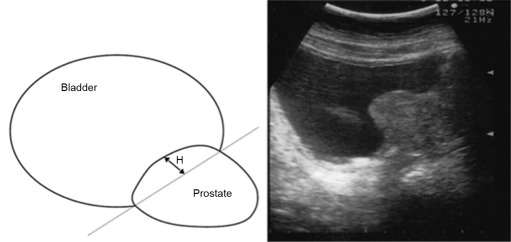
Can intravesical prostatic protrusion predict bladder outlet obstruction even in men with good flow?
Alvin Lee, Han Jie Lee, Kok Bin Lim, Hong Hong Huang, Henry Ho, Keong Tatt Foo
Asian Journal of Urology, 2016, 3(1): 39-43.
doi:10.1016/j.ajur.2015.10.002
 摘要
摘要
(
408 )
 PDF
PDF (828KB)
(
491
)
Objective: Men with benign prostate hyperplasia (BPH) with good urinary flow may still have bladder outlet obstruction (BOO). Intravesical prostatic protrusion (IPP) has been shown to be able to predict BOO. We aim to investigate the use of IPP to predict BOO in men with good urinary flow.
Methods: One hundred and fourteen consecutive men (>50 years old) presenting with lower urinary tract symptoms suggestive of BPH were recruited in 2001 and 2002. They were evaluated with serum prostate specific antigen (PSA), uroflowmetry and transabdominal ultrasound measurement of IPP and prostate volume (PV). Pressure-flow urodynamic studies were performed on all men and BOO was defined by BOO index > 40. Men with Qmax ≥12.0 mL/s were considered to have good flow.
Results: Among the 114 men, 61 patients had good urinary flow. Their median age, PV and Qmax were 66 years, 32.9 mm3 and 14.5 mL/s respectively. 14/61 (23.0%) patients had BOO and their distribution of IPP were as follows: Grade 1 e 0/20 (0%) obstructed, Grade 2-6/22 (27.3%) and Grade 3-8/19 (42.1%). Sensitivity of Grade 2/3 IPP for BOO was 100% while specificity of Grade 3 IPP was 76.6%. The area-under-curve (AUC) for IPP was greater than that for PV (0.757 vs. 0.696).
Conclusion: Even in men with good flow, high grades of IPP were more likely to have BOO and hence, may be a useful adjunct to predict BOO.
参考文献 |
相关文章 |
计量指标
|
|
|
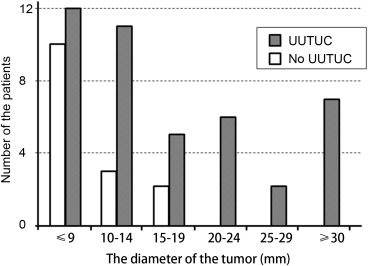
Who needs further evaluations to diagnose upper urinary tract urothelial cancers among patients with abnormal fi ndings by enhanced CT?
Akio Takayanagi, Atsushi Takahashi, Fumimasa Fukuta, Manabu Okada, Masahiro Matsuki, Shunsuke Sato, Teruhisa Uehara, Shuichi Kato, Yoshio Takagi
Asian Journal of Urology, 2016, 3(1): 44-48.
doi:10.1016/j.ajur.2015.11.005
 摘要
摘要
(
406 )
 PDF
PDF (587KB)
(
225
)
Objective: We evaluated who would need further evaluations such as retrograde pyelography (RP) and/or ureteroscopy to diagnose upper urinary tract urothelial cancers (UUTUCs) when abnormal findings for the upper urinary tract (UUT) were detected by enhanced computed tomography (CT).
Methods: We retrospectively analyzed 125 patients who underwent enhanced CT for various reasons and had abnormal findings for the UUT. Patients whose tumors were suspected to be of extraureteral origin were excluded. All patients received RP and/or ureteroscopy to evaluate the UUTUCs.
Results: The median age of the 125 patients was 70 years and gross hematuria (26.4%) was the most frequently observed symptoms. RP, ureteroscopy and both were performed for 121, 59 and 55 patients, respectively. CT revealed tumor-like lesions in 58 patients and the other patients had non-tumor-like lesions. UUTUCs were found in 43 (34.4%) of the 125 patients. All of them had tumor-like lesions on CT. In 58 patients who had tumor-like lesions on CT, univariate and multivariate analyses revealed that tumor diameter and tumor enhancement were significant predictive factors for UUTUCs. ROC curve analysis of enhanced CT to diagnose UUTUCs revealed that a tumor diameter of 18 mm was the best cutoff point. The sensitivity, specificity and accuracy were 90.0%, 98.8% and 92.7% for RP and 95.5%, 100% and 97.1% for ureteroscopy, respectively. Both of them had high sensitivity, specificity and accuracy.
Conclusion: We should decide to evaluate the UUT according to the tumor diameter on enhanced CT. When we evaluate the UUT in patients with tumor diameters of less than 20 mm, ureteroscopy is recommended.
参考文献 |
相关文章 |
计量指标
|
|
|

Tumour lysis syndrome: A rare acute presentation of locally advanced testicular cancer-Case report and review of literature
Marcus Chow, Arianto Yuwono, Ronny Tan
Asian Journal of Urology, 2016, 3(1): 49-52.
doi:10.1016/j.ajur.2015.09.005
 摘要
摘要
(
308 )
 PDF
PDF (458KB)
(
230
)
Tumour lysis syndrome (TLS) is a potentially fatal complication of malignancy or its treatment. This uncommon syndrome comprises laboratory findings of hyperuricaemia, hypocalcaemia, hyperkalaemia and hyperphosphataemia. A literature search revealed a total of eight patients, with testicular cancer, who had TLS. All these patients had metastatic disease. We present a unique case of a 47-year-old gentleman we saw in clinic, who presented with a rapidly growing right groin mass and acute breathlessness, and discuss the diagnosis and management of TLS. TLS is extremely rare in testicular cancer but necessitates the awareness of urologists. TLS can occur spontaneously in testicular malignancy. Cell lysis in a rapidly proliferating germ cell tumour is a possible mechanism. The prompt identification and institution of management for TLS is crucial to improve clinical outcomes.
参考文献 |
相关文章 |
计量指标
|
|
|
A case of giant prostatic hyperplasia
Luke Wang, Paul Davis, Kevin McMillan
Asian Journal of Urology, 2016, 3(1): 53-55.
doi:10.1016/j.ajur.2015.10.004
 摘要
摘要
(
435 )
 PDF
PDF (1609KB)
(
281
)
Benign prostatic hyperplasia (BPH) is one of the most common conditions experienced by aging males and a frequent cause of bladder outlet obstruction and macroscopic haematuria. Giant prostatic hyperplasia (GPH) is an extremely rare form of prostatic hyperplasia. We present a case of a patient with GPH of 800 mL. To our knowledge, this is the fourth largest prostatic hyperplasia ever reported in the literature.
参考文献 |
相关文章 |
计量指标
|
|
|
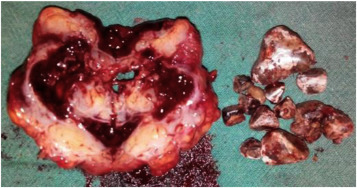
Unusual case of nephrocutaneous fi stula -Our experience
Rajeev Thekumpadam Puthenveetil, Debajit Baishya, Sasanka Barua, Debanga Sarma
Asian Journal of Urology, 2016, 3(1): 56-58.
doi:10.1016/j.ajur.2015.10.005
 摘要
摘要
(
321 )
 PDF
PDF (1560KB)
(
347
)
A rare case of nephrococutaneous fistula due to spontaneous expulsion of renal calculi is described. A 45-year-old man presented with urinary leakage from an ulcer over the left lumbar region for the last 3 months after a history of spontaneous expulsion of stones from this area. Ultrasonography abdomen revealed a small contracted kidney with multiple calculi in the kidney and renal pelvis, sinus tract from the lower pole of the left kidney with a ruptured calyceal calculus in the sinus tract. CT urography revealed a non excreting left kidney with multiple renal calculi, with hyperdense collection in the renal parenchyma extending to the subcutaneous tissue and left lung suggesting a xenthogranulomatous pyelonephritis (XGP). We performed a left-sided simple nephrectomy with excision of the fistulous tract. Histopathological examination revealed XGP. There have been a few case reports of XGP forming nephrocutaneous fistula in the back.
参考文献 |
相关文章 |
计量指标
|
|
 当期目录
当期目录
